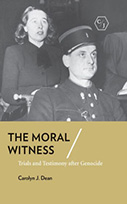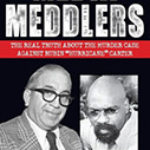The Moral Witness: Trials And Testimony After Genocide

Author: Carolyn J. Dean
Publisher: Ithaca, NY: Cornell University Press, 2019. 188p.
Reviewer: Lynn Rapaport | September 2019
In The Moral Witness, Carolyn Dean traces how victims of mass atrocities have become witnesses to them, as the moral witness emerged as a central trope in Western civilization over the last hundred years. By analyzing interwar and postwar trials, she identifies four iterations of the moral witness: the righteous avenger in the interwar period, the concentration camp survivor in the postwar period, the Holocaust survivor in the 1960s and 1970s, and the global victim and counter-witness since the 1990s. The book is divided into four chapters that describe each iteration and time-period, and shows how different rhetorical features and contexts helped shape a narrative about witnessing genocide that came to symbolize Western moral culture. Dean provides a bird’s-eye-view of each iteration, taking the reader into the trials and thereby painting a fascinating picture of “the moral witness.”
Chapter 1, The Righteous Avengers, focuses on the trials of Soghomon Tehlirian (1921) and of Samuel Schwarzbard (1927), the first major trials in Western Europe featuring victims seeking justice from interethnic violence and state–sponsored mass murder. Dean describes in detail how in an affluent Berlin neighborhood on March 15, 1921 Tehlirian, whose family perished in the Armenian genocide, shot Talaat Pasha, one of the men responsible for its planning. After the defeat of the Ottoman Empire, Talaat fled to Berlin to avoid trail by the Allies. Tehlirian rented a room across the street from where Talaat lived, followed his routine, and shot him the back of the head. He then ran, but was caught by bystanders who hailed police who arrested him for premeditated murder.
In Paris, five years later, Samuel Schwarzbard, was put on trial for killing Symon Petliura, the former head of the Ukrainian National Republic, who had been commander of the Ukrainian Directory’s army, and had allegedly organized the 1917 pogroms that killed fifty to sixty thousand Jews, and wounded many more. Schwarzbard, originally from Bessarabia, immigrated to France in 1910 to escape political repression in Russia, and acquired French citizenship in 1916. He learned that Petliura was living in Paris as the head of the Ukrainian government in exile. On May 25, 1926, Schwarzbard shot Petliura five times in the head, as well as a few more times after he was already dead. Schwarzbard was arrested and put on trial for murder. Dean shows how in both trials the defense and prosecution emphasized the atrocities suffered by the Armenians and Jews respectively. Juries heard witness accounts from victims of the Armenian genocide and from the military pogroms and inhumane treatment against Jewish villages, thereby turning the assassins into righteous avengers. In the absence of any yet-established legal redress against state sponsored atrocities, the trials recast Tehlirian and Schwarzbard as vigilantes, acquitted them of murder, and formed an innovative victim-centered concept of “witness” that demanded humanitarian justice.
In chapter 2, Dean takes an in-depth look at witnesses to prison camps in the Soviet Union through the libel cases of Victor Kravchenko in 1949, and David Rousset in 1950-51. Kravchenko, a Soviet government engineer working at the Soviet Purchasing Commission in Washington DC, defected to the United States in 1944. Anti-Soviet writers in the United States helped him translate his articles and best-selling book, I Chose Freedom, that depicted starvation in the Ukrainian famine, party purges, and the arrest and torture of those in forced labor camps. In November 1947, the pro-Soviet magazine, Les Lettres françaises, published an article by Sim Thomas, who claimed that Kravchenko was a US spy who fabricated or plagiarized most of his book. Kravchenko named the editor and Thomas and another contributor in a libel suit against the magazine. Kravchenko’s legal team put the Stalinist regime on trial, attempting to show that Soviet labor camps were as brutal as Nazi ones. Witnesses including Margarete Buber-Neumann — who survived the Soviet camp at Karaganda, as well as the Nazi camp Ravensbrück, near Berlin — provided moving testimony, but these witnesses were unable to overtake the Cold War court battle between French Communists, who argued for the defense, and their detractors. Nonetheless, Kravchenko prevailed in his libel suit with a symbolic settlement, due to the legal narratives of the prosecution, who in the absence of a statute condemning crimes of genocide, were able to transform victim testimony into powerful narratives of suffering.
In 1949, David Rousset, a survivor of the Nazi’s Buchenwald, issued an appeal in Le Figaro littéraire, a French newspaper, to former inmates of Nazi concentration camps to join him in investigating whether there were similar camps in the Soviet Union. Rousset believed that slave labor and extermination camps differed only by a matter of degree. Pierre Daix, the writer and journalist who had been in Mauthausen, criticized Rousset in an article in Les Lettres françaises accusing him of false accounts of the Soviet Gulag. Rousset sued the magazine and Daix for libel, and the two-month trial ended in January 1951, with a victory for Rousset. Rousset argued that his libel suit was not about his political views toward the Soviet Union, but motivated by humanitarian concerns, and whether “crimes against humanity” were being perpetrated by the Soviet Union. Historians interpreted the Rousset trial as a repeat of Kravchenko’s, with the same defendant, lawyers, and testimony by Buber-Neumann. Actually, additional witnesses had been called, and the Rousset trial stressed the distinctiveness of Nazi and Stalinist camps from other experiences of atrocity, thus transforming survivors into “specialists” — expert witnesses with an authoritative source of knowledge, who speak for all victims as well as potential ones.
Dean focuses on the “The Holocaust Witness” in chapter 3, by analyzing testimony from the 1961 trial of Nazi Adolph Eichmann, and observers’ interpretations, both during and decades after that trial. She argues that the Zionist narrative was the organizing framework for testimony during the trial, transferring victims’ survival in redemptive, heroic terms, and transmitting their experience publically as a message to the world about a specific type of human degradation. Dean shows how Holocaust survivors conveyed the “terrors of death” on the witness stand by illustrating the psychological suffering they endured, which differed from survivors of conventional wars, since they were reacting to planned and targeted murder by the Nazis. Dean shows how following the Eichmann trial, analysts moved away from “victim blaming,” and stigmatizing Holocaust survivors as being weak by not resisting, and transformed their survival into a new type of heroism. For example, Dean argues that in the early 1960s, filtered through Hannah Arendt’s Eichmann in Jerusalem, three authors–Bruno Bettelheim, Robert Jay Lifton, and Terrence Des Pres—contributed to a new narrative about Jewish Holocaust survivors, recasting them into symbols of suffering humanity and expert witnesses of its destruction. In the 1960s, the meaning of survival and the icon of the “witness to genocide” emerged in the United States and in the West as a powerful antidote to victim blaming, as had been characterized by Bettelheim’s concept of “identification with the aggressor,” and Arendt’s argument about Jewish Council complicity. In the early 1960s, Elie Wiesel explained that audiences were ill-equipped to understand the novel circumstances of Jewish death and survival, and thus blamed them for their own deaths. Wiesel interpreted and transformed Jewish survival into a heroic accomplishment. Lifton’s emphasis on neurosis and psychological suffering in the Japanese city of Hiroshima (after it was bombed in 1945) and Holocaust victims, universalized trauma– he saw more similarities than differences between these two sets of survivors. However, it was Des Pres in the 1970s, criticizing the psychological approaches of Bettelheim and Lifton, who helped replace heroic resistance with heroic survival, providing a positive view of survivors by emphasizing the importance of bearing witness, thereby transforming survival into an identity—a metaphor for all genocidal suffering.
Chapter 4 describes the global witness, that Dean argues is a new incarnation of the Holocaust witness, based on the creation in 1998 of the International Criminal Court (ICC), NGO’s like Doctors Without Borders, exhibitions, museums, and other humanitarian and human rights organizations and publications. Dean argues that these organizations act as third-party witnesses committed to the global victims’ care and empowerment. With new diagnoses of Post-Traumatic Stress Disorder (PTSD), and atrocity images becoming staples of human rights activism, the global victim becomes a generic one, no longer tied to a specific event, and thus stripping victims of agency. Dean shows how international courts, like the ICC, subordinate victims interests to those of the tribunals. Dean also introduces the counter-witness, a symbol of implicit criticism of institutionalized compassion, whereby victims become pawns in larger political games, and subjects of voyeuristic gazes that reflect stigmas associated with powerlessness and structural weakness related to global justice.
All told, Dean has provided a sophisticated and nuanced analysis of the emergence of “the witness” as a moral symbol and pervasive icon of suffering and surviving genocide and mass atrocities. Her meticulous and insightful analysis of courtroom trials and testimony of genocide throughout the twentieth century show how “the witness” came to symbolize Western moral culture. She identifies patterns of cultural representation of “the moral witness,” depicting numerous changes and iterations, during interwar and postwar trials that recognized victims of mass atrocities. The book will be valuable to students and scholars who study genocide, testimony, victimhood, and social and cultural trauma in the aftermath of mass atrocities.
Lynn Rapaport, Henry Snyder Professor of Sociology, Pomona College


